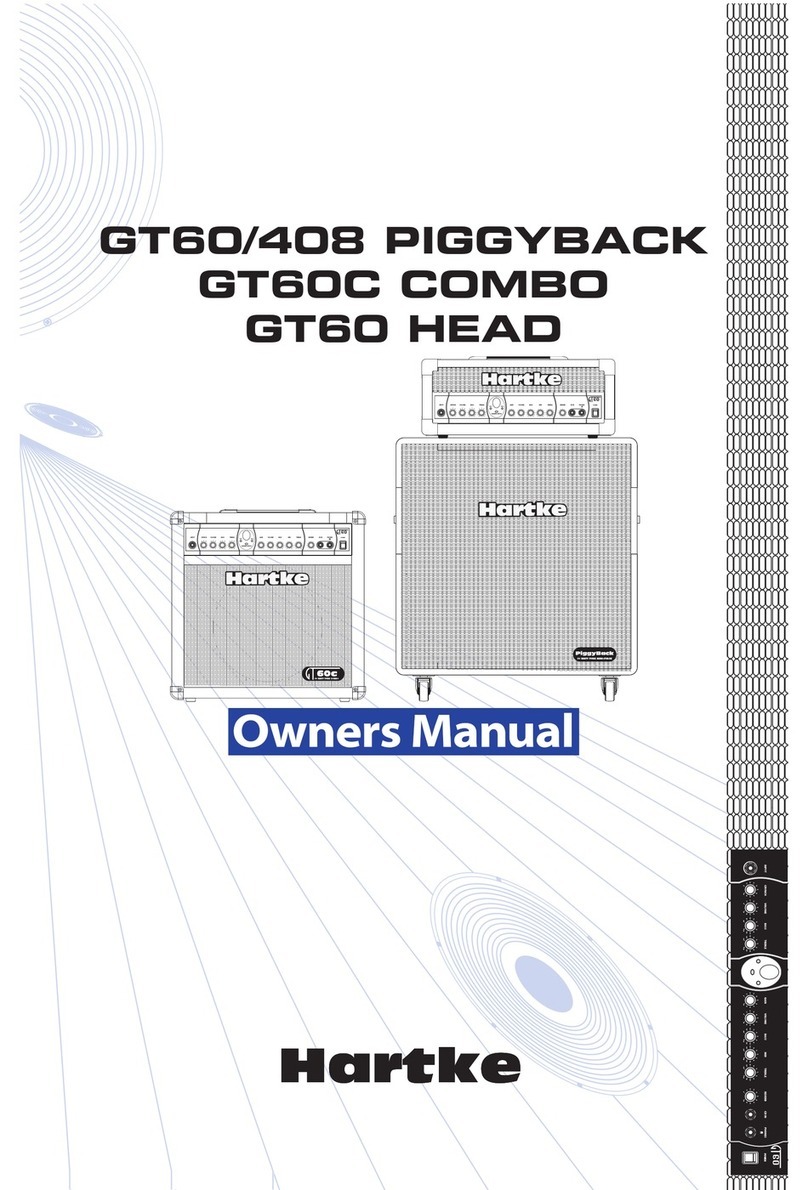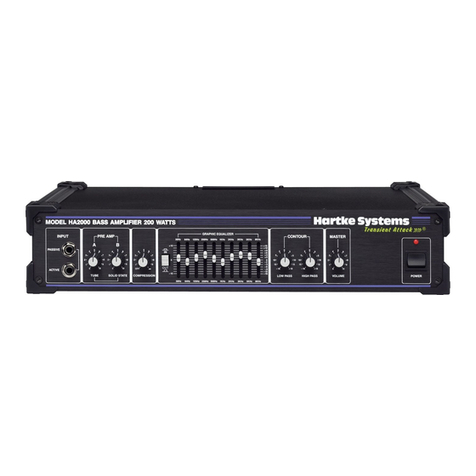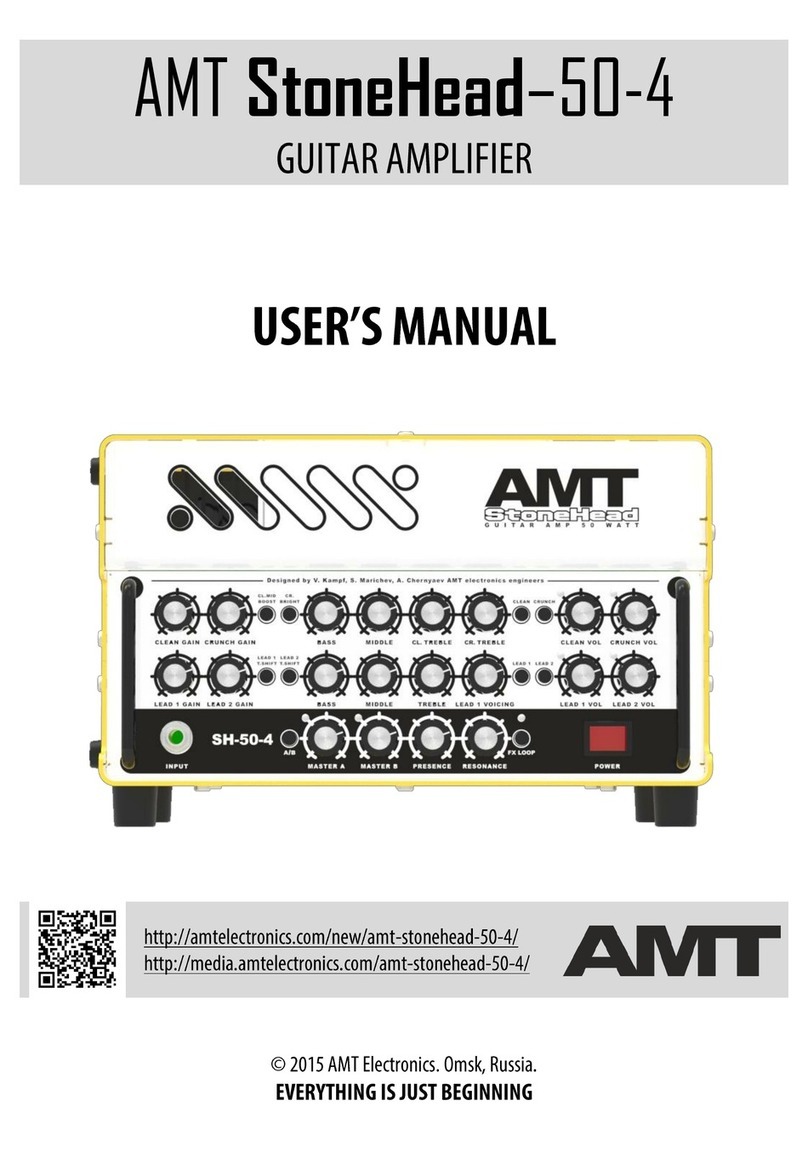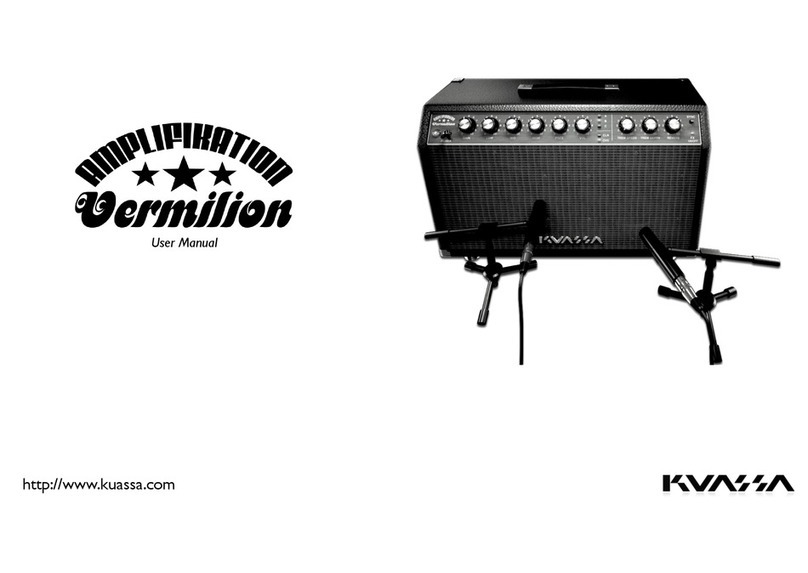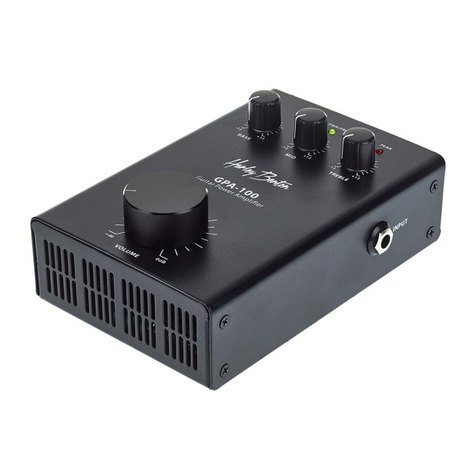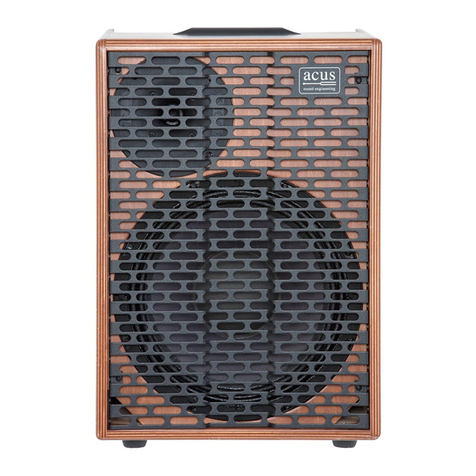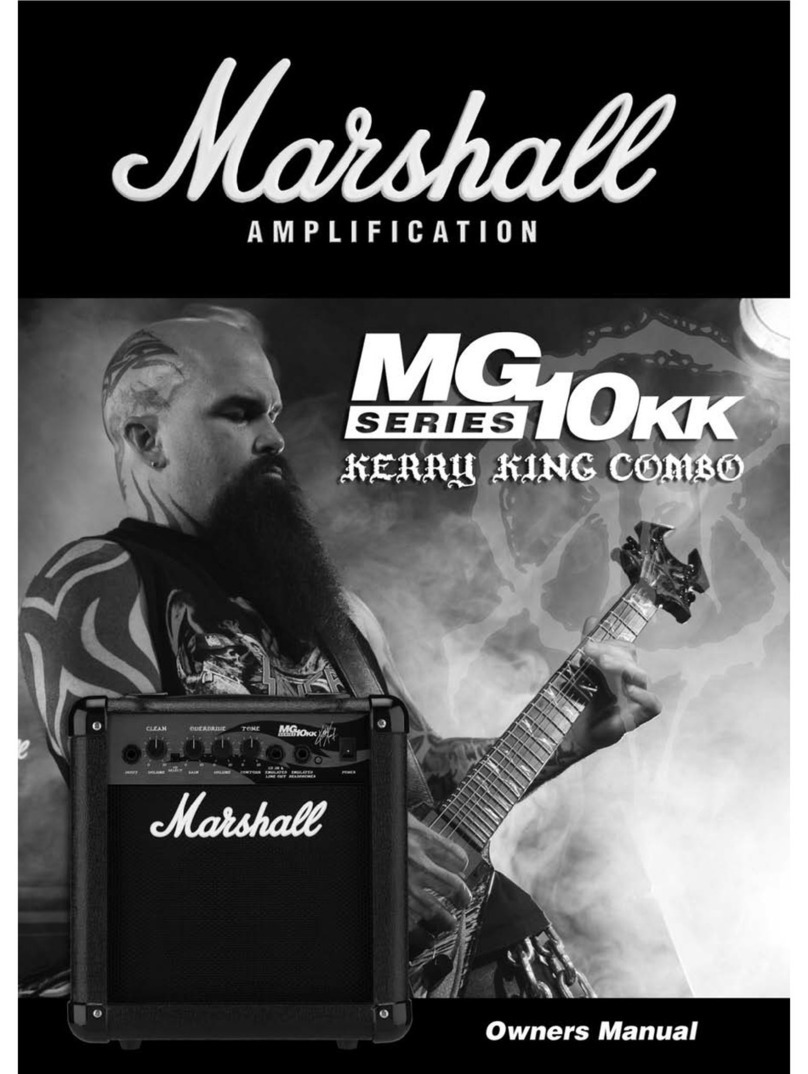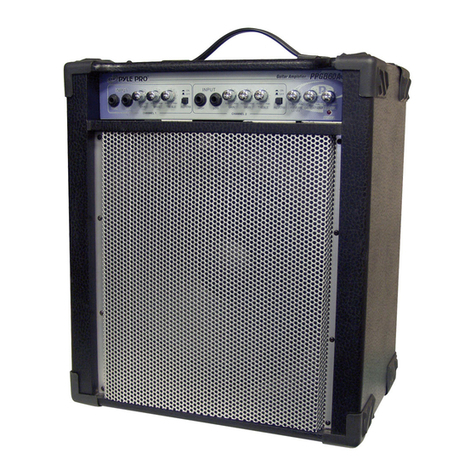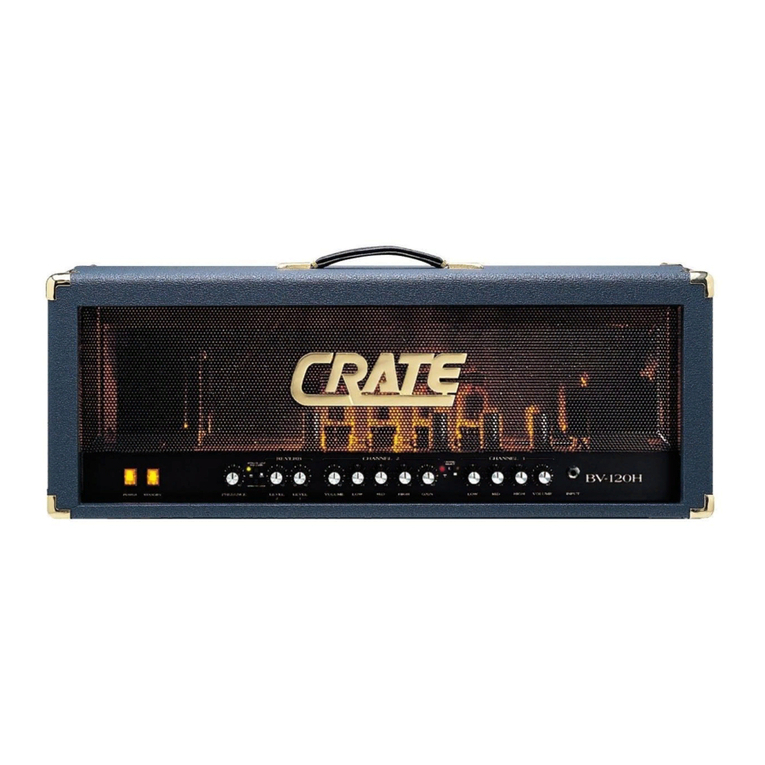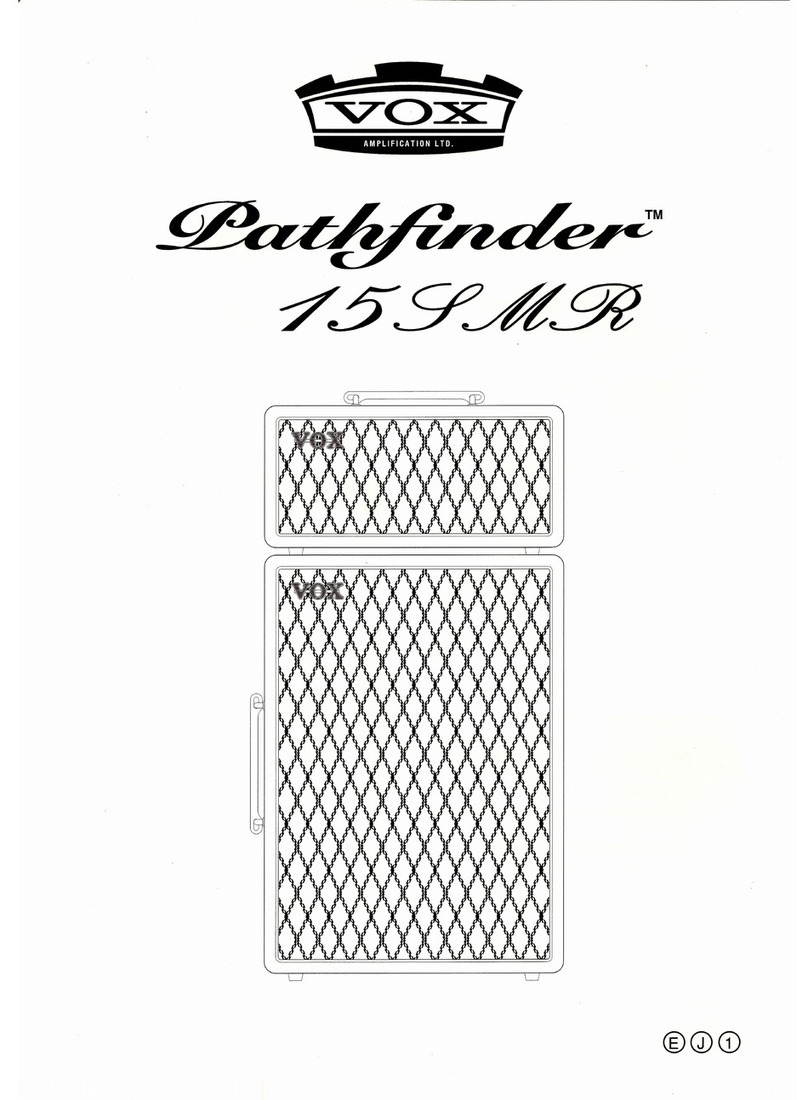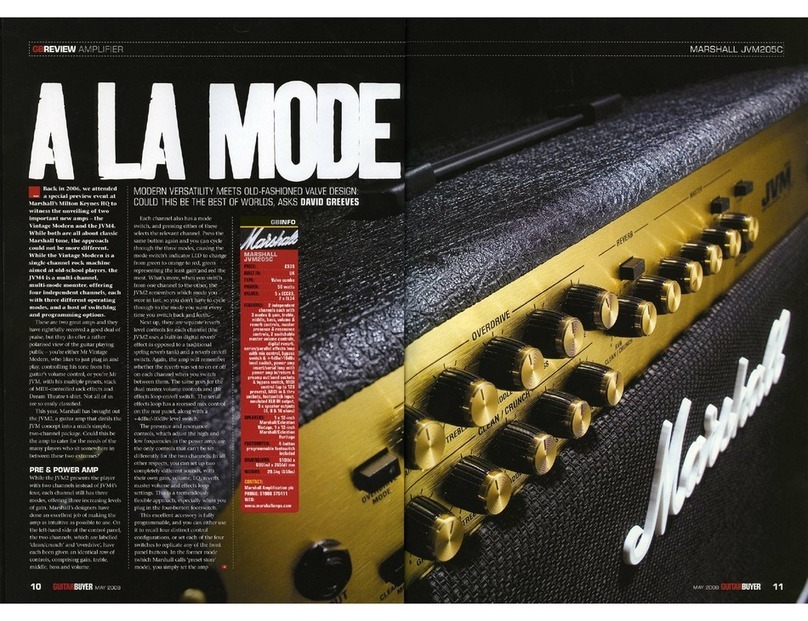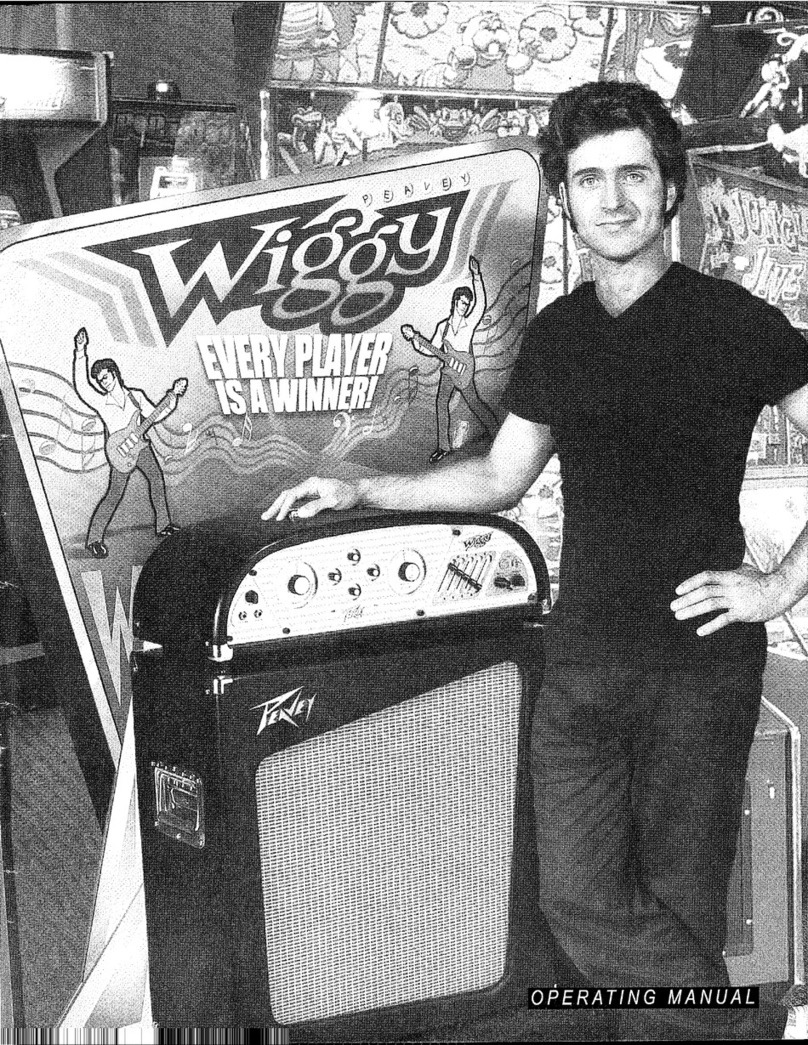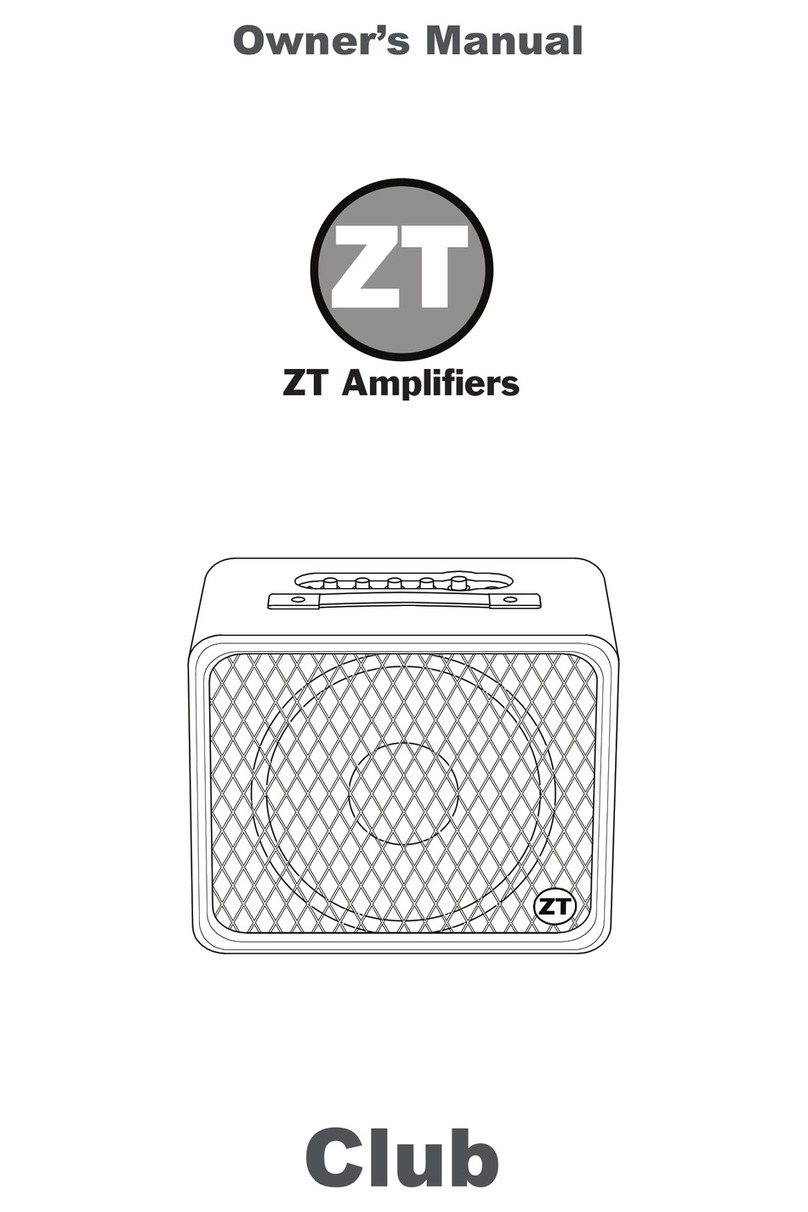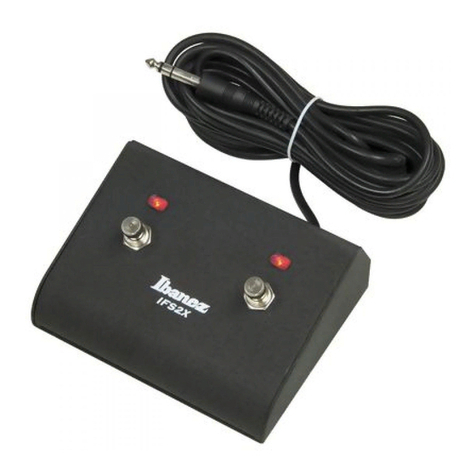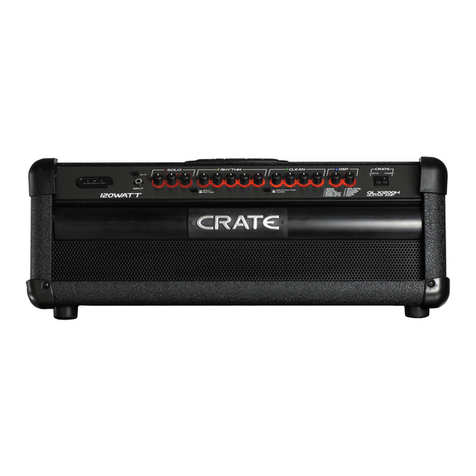Hartke B90 User manual

100
115
145
215 320 450
770
850
900
90 1K
-12
-9
-6
-3 0+3
+6
+9
+12
-15 +15
-12
-9
-6
-3 0+3
+6
+9
+12
-15 +15
-12
-9
-6
-3 0+3
+6
+9
+12
-15 +15
1
2
3
456
7
8
9
010
POWERLINE OUTBASS MID HIGHVOLUME SHAPE PHONES
B60
BASS AMPLIFIER 60 WATTS
1 INPUTS 2
PASSIVE ACTIVE
-12
-9
-6
-3 0+3
+6
+9
+12
-15 +15
-12
-9
-6
-3 0+3
+6
+9
+12
-15 +15
-12
-9
-6
-3 0+3
+6
+9
+12
-15 +15
1
2
3
456
7
8
9
010
1 INPUTS 2
B30
BASS AMPLIFIER 30 WATTS
POWERLINE OUTBASS MID HIGHVOLUME PHONES
PASSIVE ACTIVE
-12
-9
-6
-3 0+3
+6
+9
+12
-15 +15
-12
-9
-6
-3 0+3
+6
+9
+12
-15 +15
-12
-9
-6
-3 0+3
+6
+9
+12
-15 +15
1
2
3
456
7
8
9
010
POWERLINE OUTBASS MID HIGHVOLUME PHONES
1 INPUTS 2
B20
BASS AMPLIFIER 20 WATTS
PASSIVE ACTIVE
100
115
145
215 320 450
770
850
900
90 1K
-12
-9
-6
-3 0+3
+6
+9
+12
-15 +15
-12
-9
-6
-3 0+3
+6
+9
+12
-15 +15
-12
-9
-6
-3 0+3
+6
+9
+12
-15 +15
1
2
3
456
7
8
9
010
POWERLINE OUTBASS MID HIGHVOLUME SHAPE PHONES
B90
BASS AMPLIFIER 90 WATTS
1 INPUTS 2
PASSIVE ACTIVE
Hartke
BASS
COMBO
BB SSEERRIIEESS
OWNERS MANUAL

Produced by On The Right Wavelength for Samson Technologies Corp.
Copyright 1998, Samson Technologies Corp.
Printed August, 1998
Samson Technologies Corp.
575 Underhill Blvd.
P.O. Box 9031
Syosset, NY 11791-9031
Phone: 1-800-3-SAMSON (1-800-372-6766)
Fax: 516-364-3888
Table of Contents
ENGLISH
Introduction 3
B Series Combo Bass Amplifier Features 4
Guided Tour 5
Front Panel 5
Rear Panel 7
Setting Up and Using Your Hartke B Series Combo Bass Amplifier 8
Using Equalization and Shape 10
Specifications 33
FRANCAIS
Introduction 12
Caractéristiques 13
Visite guidée 14
Face avant 14
Face arrière 16
Paramétrage et utilisation de votre amplificateur combo Série B Hartke 17
Spécifications 33
DEUTSCHE
Einleitung 19
Systemmerkmale 20
Übersicht 21
Vorderseite 21
Rückseite 23
Einstellung und Bedienung Ihres Combo-Verstärkers Serie B Hartke 24
Technische Daten 33
ESPANOL
Introducción 26
Características del Sistema 27
Recorrido guiado 28
Panel frontal 28
Panel trasero 30
Ajuste y utilización de su Amplificador combo Hartke de la Serie B 31
Especificaciones 33

Introduction
We know you don’t like reading owners manuals, but you’ve just purchased one of the
finest bass amplifiers around, and we want to tell you about it! So, before you plug in and
start popping and slapping, we’d like to suggest you take just a few moments out to scan
these pages. We’ll make it as painless as possible, we promise—and , who knows, you
might just pick up a tip or two.
The B Series is a powerful combo amplifier which includes a matched 8-ohm bass
speaker in a specially designed cabinet. It’s the perfect system for use in small venues
such as club dates and for home recording studio. Plus, its dedicated headphone output
makes it an awesome practice amp!
There are five different models in the B Series, and this manual covers them all. The B20
is the baby of the family; it's got a 20-watt amp and an 8" speaker. Next up is the B30,
which has a 30-watt amp and a 10" speaker. Jumping to twice the power, the B60 pumps
60 watts into a 12" speaker. The B90 delivers a full 90 watts of bone-rattling power into a
15" speaker. And the big brother is the B120, which tops out at 120 masssive watts and
has two 12" speakers for extra low end power and dispersion. Whichever of these models
you’ve purchased, you’re assured of that great Hartke sound and robust construction.
In these pages, you’ll find a detailed description of the many features of your B Series
Combo Bass Amplifier, as well as a guided tour through its front and rear panels,
step-by-step instructions for setting up and using the amp, additional information about
equalization and a unique Shape control (provided in the B60, B60 and B120 models),
plus full specifications. You’ll also find a warranty card enclosed—please don’t forget to fill
it out and mail it so that you can receive online technical support and so we can send you
updated information about this and other Hartke and Samson products in the future.
Also, be sure to check out our website (http://www.samsontech.com) for complete
information about our full product line.
SPECIAL NOTE: Should your Hartke B Series Combo Bass Amplifier ever require
servicing, a Return Authorization (RA) number is necessary. Without this number, the
unit will not be accepted. If purchased in the United States, please call Samson at
1-800-372-6766 for a Return Authorization number prior to shipping. Please retain the
original packing materials and, if possible, return the unit in its original carton and packing
materials. If purchased outside the United States, please contact your local distributor for
warranty information.
3
ENGLISH

Hartke B Series
Combo Bass Amplifier Features
The Hartke B Series offers all the newest concepts in state-of-the-art bass amplification at
an extremely affordable price. Here are some of its main features:
•Bipolar circuit design ensures that every nuance of your bass performance is
reproduced faithfully.
•Dual inputs that accommodates a broad range of input levels, so that you can use the
B Series with pretty much any kind of bass, from passive models to those with active
circuitry. It is almost impossible to overload the input of a B Series bass amplifier!
•Three bands of high-quality equalization, allowing you to create a broad range of
tonal colors for your bass instrument.
•Line-level effects loop send (Preamp Out) and return (Amp In) jacks that allow you to
connect to professional outboard effects processors.
•A separate headphone output which automatically disconnects the speaker output,
allowing use as a high-quality practice amp.
•A unique front-panel line-level output for interfacing with PA systems or recording
mixing consoles.
•Included is a matched Hartke 8-ohm speaker mounted in a specially designed
cabinet for clean, crisp sound. The B120 cabinet includes two perfectly matched
Hartke speakers—one front-facing and the other down-facing for extra range and
dispersion of low frequencies.
•In the B60, B90 and B120 models, a unique contour filtering system called “Shape”
which activates a multi-band equalization curve specially designed to enhance the
sound of the electric bass. The front panel Shape control enables you to continuous-
ly sweep a filter through various frequency areas in order to customize the effect of
the curve to the specific tonal characteristics of your particular bass instrument.
•Permanently attached power cord supplied with the correct plug for your geographic
area.
•Rugged construction makes the B Series eminently road-worthy.
4
ENGLISH

Guided Tour - Front Panel
1. Inputs - Connect your bass guitar to one of these standard 1/4" unbalanced jacks.
If your bass has passive electronics (that is, if it has no battery), connect it to Input 1, which
is designed to handle low-level signals. If your bass has active electronics (that is, if it has
a battery), connect it to Input 2, which employs a 10 dB pad and is designed to handle
hotter bass pickup signals.
2. Volume control - This is the overall volume control. For best signal-to-noise ratio, keep
the output of your bass at or near maximum and adjust the B Series Volume to the desired
level.
3. Shape control (B60, B90 and B120 only) - This control applies a specialized 20 dB
notch filter to the specified frequency area so that you can customize the effect of the
Shape curve to best complement your particular bass instrument. Moving the Shape
control clockwise causes the notch filter to be applied to higher frequencies while moving it
counterclockwise causes it to be applied to lower frequencies. At the fully clockwise
position, the filter is applied to the 1 kHz frequency area; this will act to attenuate
mid-range frequencies and give your bass a deep, low tone. At the fully counterclockwise
position, the filter is applied to the 90 Hz frequency area; this will act to attenuate low
frequencies and give your bass a biting, trebly sound. For more information, see the
“Using Equalization and Shape”section on page 8 in this manual.
5
100
115
145
215 320 450
770
850
900
90 1K
-12
-9
-6
-3 0+3
+6
+9
+12
-15 +15
-12
-9
-6
-3 0+3
+6
+9
+12
-15 +15
-12
-9
-6
-3 0+3
+6
+9
+12
-15 +15
1
2
3
456
7
8
9
010
POWERLINE OUTBASS MID HIGHVOLUME SHAPE PHONES
PASSIVE ACTIVE
B90
BASS AMPLIFIER 90 WATTS
1234 5 6789
1 INPUTS 2
100
115
145
215 320 450
770
900
90 1K
850
-12
-9
-6
-3 0+3
+6
+9
+12
-15 +15
-12
-9
-6
-3 0+3
+6
+9
+12
-15 +15
-12
-9
-6
-3 0+3
+6
+9
+12
-15 +15
1
2
3
456
7
8
9
010
POWERLINE OUTBASS MID HIGHVOLUME SHAPE PHONES
PASSIVE ACTIVE
B90
BASS AMPLIFIER 90 WATTS
Hartke
1 INPUTS 2
ENGLISH
100
115
145
215 320 450
770
900
90 1K
850
-12
-9
-6
-3 0+3
+6
+9
+12
-15 +15
-12
-9
-6
-3 0+3
+6
+9
+12
-15 +15
-12
-9
-6
-3 0+3
+6
+9
+12
-15 +15
1
2
3
456
7
8
9
010
POWERLINE OUTBASS MID HIGHVOLUME SHAPE PHONES
PASSIVE ACTIVE
B120
BASS AMPLIFIER 90 WATTS
Hartke
1 INPUTS 2
B120
second
speaker

Guided Tour - Front Panel
4. Low EQ control - This control provides approximately 15 db of cut or boost at 100 Hz,
with a peak (bell) curve. When the knob is at the 12 o’clock (“0”) position, there is no
boost or attenuation (that is, flat response). As it is turned clockwise from the “0”position,
the frequency area is boosted; as it is turned counterclockwise from the “0”position, the
frequency area is attenuated. For more information, see the “Using Equalization and
Shape”section on page 8 in this manual.
5. Mid EQ control - This control provides approximately 15 db of cut or boost at 830 Hz,
with a peak (bell) curve. When the knob is at the 12 o’clock (“0”) position, there is no
boost or attenuation (that is, flat response). As it is turned clockwise from the “0”position,
the frequency area is boosted; as it is turned counterclockwise from the “0”position, the
frequency area is attenuated. For more information, see the “Using Equalization and
Shape”section on page 8 in this manual.
6. High EQ control - This shelving control provides approximately 15 db of cut or boost
at 5 kHz. When the knob is at the 12 o’clock (“0”) position, there is no boost or attenuation
(that is, flat response). As it is turned clockwise from the “0”position, the frequency area
is boosted; as it is turned counterclockwise from the “0”position, the frequency area is
attenuated. For more information, see the “Using Equalization and Shape”section on
page 8 in this manual.
7. Line Out - This standard unbalanced 1/4" jack provides a line-level post-EQ and
post-Volume (and, in the B60, B90 and B120 models, post-Shape) output signal from the
B Series. You’ll usually use this to connect the B Series signal to a line-level input when
interfacing with PA systems or recording mixing consoles. The signal from this output is
the same as that from the Preamp Out on the rear panel (see #3 on page 5).
8. Headphones jack - Connect any standard stereo headphone (600 ohms or less) to
this standard 1/4" stereo jack. When a plug is inserted into the headphone jack, the
speaker output is disconnected, allowing you to use your B Series as a practice amplifier.
The level of the signal sent to the headphones is determined by the setting of the Volume
knob—at the point where a connected speaker would clip, the headphones will clip.
WARNING: Because even the smallest B Series amplifier is capable of generating
extremely high headphone signal levels, always start with the Volume knob at
minimum and then slowly turn it up. In particular, a clicking sound is an indication
of distortion and possible damage to the headphones (and/or your hearing!); don’t
let things get to that point!
9. Power switch - Use this to power the B Series on or off. When powered on, an LED
inside this switch is lit.
6
ENGLISH

7
1. Fuse holder (B60, B90 and B120 only) - Holds an appropriately rated fuse for your
model. If you need to change this fuse for any reason, replace it with one that has the
same exact rating:
B60: 2.0 amp for 115 volt operation; 1.0 amp for 230 volt operation
B90: 3.0 amp for 115 volt operation; 1.6 amp for 230 volt operation
B120: ?? amp for 115 volt operation; ?? amp for 230 volt operation
2. AC Power Cord - Use this permanently attached grounded AC power cord to connect
your B Series amplifier to mains power. This cord comes supplied with the appropriate
plug for your geographic area. CAUTION: Do not use an adapter to defeat the third
grounding pin on this plug or severe electric shock may result!
3. Preamp Out (Effects Loop Send)- Use this 1/4" unbalanced jack to send signal to a
professional outboard effects processor.* Output level is approximately 0 dB to +4 dB and
is post-EQ and post-Shape but unaffected by the setting of the Volume control. The
signal from this output is the same as that from the Line Out on the front panel (see #7 on
page 4).
4. Amp In (Effects Loop Return)- Use this 1/4" unbalanced jack to return signal from a
professional outboard effects processor.*
* In-line effects (such as footpedals) intended for low signal levels should be placed
between your bass and the front panel B Series amplifier Input and not connected with the
rear panel Effects Loop jacks.
Guided Tour - Rear Panel
B90
EFFECTS LOOP
SERIAL
NUMBER
CAUTION
FOR CONTINUED PROTECTIONAGAINST RISK
OF FIRE, REPLACE ONLYWITH SAME TYPE FUSE
ATTENTION
UTILISER UN FUSIBLE DE
RECHANGE DE MÊMETYPE Hartke
RISK OF ELECTRIC SHOCK
DO NOT OPEN
WARNING
DO NOT EXPOSETHIS EQUIPMENT
TO RAIN OR MOISTURE
AVIS
RISQUE DE CHOC ELECTRONIQUE
NE PASOUVRIR
90 WATT BASS AMPLIFIER PREAMP
OUT AMP IN
F
U
S
E
234
1
ENGLISH

8
Setting Up and Using Your Hartke
B Series Combo Bass Amplifier
Setting up your Hartke Systems B Series Combo Bass Amplifier is a simple procedure
which takes only a few minutes:
1. Remove all packing materials (save them in case of need for future service) and decide
where the amplifier is to be physically placed. To avoid potential overheating problems,
make sure that the rear panel is unobstructed and that there is good ventilation around the
entire unit.
2. Connect the 3-pin AC plug into any grounded AC socket. Don’t turn the B Series on
just yet, though.
3. Use a standard music instrument cable to connect your
bass to one of the Input jacks on the front panel. If your
bass has passive electronics (that is, if it has no battery),
connect it to Input 1, which is designed to handle low-
voltage signals. If your bass has active electronics (that is,
if it has a battery), connect it to Input 2, which has a 10 dB
pad and is designed to handle hotter bass pickup signals.
4. On the front panel of the B Series, turn the Volume control to its
minimum (fully counterclockwise) position, set all three EQ controls
to their “0”(12 o’clock) position, and, if you are using a B60, B90 or
B120, set the Shape control to its 12 o’clock position.
5. Press the front panel Power switch in order to turn on your
B Series amp; the LED in the switch will light up.
6. Set the output of your bass to maximum and then, while playing,
slowly turn the B Series Volume control up until the desired level is
achieved. It’s nearly impossible to overload the B Series amplifier, so
if you hear distortion even at low Volume settings, check for a faulty
cable (if it’s good, simply back off the output of your bass).
7. If you are using a B60, B90 or B120, turn the Shape knob both
clockwise and counterclockwise to hear the effect of the Shape curve
and filter on the sound of your bass. Leave the Shape knob at the
point where it best complements your particular instrument and
playing style.
8. Adjust the three equalization controls to taste
(when you get a great setting that complements
your instrument and playing style, it’s a good idea
to write it down for future use).
PASSIVE ACTIVE
1 INPUTS 2
1
2
3
456
7
8
9
010
VOLUME
POWER
100
115
145
215 320 450
770
850
900
90 1K
SHAPE
-12
-9
-6
-3 0+3
+6
+9
+12
-15 +15
-12
-9
-6
-3 0+3
+6
+9
+12
-15 +15
-12
-9
-6
-3 0+3
+6
+9
+12
-15 +15
BASS MID HIGH
ENGLISH

9
Setting Up and Using Your Hartke
B Series Combo Bass Amplifier
9. Test the headphone output by turning the Volume control to its
minimum (fully counterclockwise) position and then connect a
standard stereo headphone to the front-panel Headphones jack.
While playing your bass, slowly turn the Volume control up—you
should hear sound from the headphones and none from the connected
speaker. We recommend the use of large size headphones (those
with large transducers) for optimum bass reproduction.
10. If you need to connect the B Series to a PA system or a recording
mixing console, connect a cable between the front-panel Line Out
output and a line-level input on the mixer. (See #7 on page 4 in this
manual for more information on the use of the B Series Line Out).
11. If you’re using a professional external signal
processor that has line-level inputs and outputs, turn
your B Series amp off momentarily and then connect a
standard audio cable between the rear panel Preamp
Out jack and your effects processor input and another
standard audio cable between the Amp In jack and your
effects processor output (if required, multiple effects
processors can be daisy-chained together, output to
input). Then turn the B Series amp back on and play
your bass while adjusting the controls of your effects
processor(s). For best results, set both the input and
output gain of all connected effects processor(s) to 0 dB
(unity gain), so that there is no increase or decrease in
level whether the effects are switched in or out.
If you encounter difficulty with any aspect of setting up or using your Hartke B Series Bass
Combo Amplifier, you can call Samson Technical Support (1-800-372-6766) between 9 AM
and 5 PM EST, or contact your local distributor.
PHONES
LINE OUT
EFFECTS LOOP
PREAMP
OUT AMP IN
ENGLISH

10
Using Equalization and Shape
The Hartke Systems B Series Bass Amplifier gives you enormous control over shaping the
sound of your bass, using a process called equalization. To understand how this works,
it’s important to know that every naturally occurring sound consists of a broad range of
pitches, or frequencies, combined together in a unique way. This blend is what gives every
sound its distinctive tonal color. The B Series EQ controls allow you to alter a sound by
boosting or attenuating specific frequency areas—they operate much like the bass and
treble controls on your hi-fi amp, but with much greater precision.
The B Series offers three bands of equalization. Each EQ knob (labeled Low, Mid, and
High, respectively) affects a different frequency area (100 Hz, 300 Hz, and 5 kHz,
respectively) and provides approximately 15 db of boost and attenuation. We carefully
selected these frequency areas because they have maximum impact on bass signals.
For example, the Low (100 Hz) control affects the very lowest audible frequencies (in fact,
most humans cannot hear below 20 Hz), while the High (5 kHz) control affects the “twang”
of a bass string.
When an EQ knob is in its center detented position (“0”), it is having no effect. When it is
moved right of center, the particular frequency area is being boosted; when it is moved left
of center, the frequency area is being attenuated. Turning all EQ controls up the same
amount will have virtually the same effect as simply turning up the Volume; conversely,
turning them all down the same amount will have virtually the same effect as turning down
the Volume. Both approaches are pointless (after all, that’s why we gave you a Volume
control!)
In many instances, the best way to deal with equalization is to think in terms of which
frequency areas you need to attenuate, as opposed to which ones you need to boost.
Be aware that boosting a frequency area also has the effect of boosting the overall signal;
specifically, too much Low EQ boost can actually cause overload distortion or even harm
the connected speaker.
In addition, the B60, B90 and B120 models provide a unique Shape control which employs
a notch filter to remove specific frequency areas. At the same time, it overlays a special
equalization curve that is designed to improve the sound of electric bass instruments.
This curve provides boost at certain frequency areas and attenuation at other frequency
areas. As the Shape knob is turned clockwise, the notch filter is imposed on higher
frequency areas; as it is turned counterclockwise, the filter is imposed on lower frequency
areas. At the fully clockwise position, the filter is applied to the 1 kHz frequency area,
making for a deep, rich tone; at the fully counterclockwise position, the filter is applied to
the 90 Hz frequency area, making for a bright, twangy tone.
-12
-9
-6
-3 0+3
+6
+9
+12
-15 +15
-12
-9
-6
-3 0+3
+6
+9
+12
-15 +15
-12
-9
-6
-3 0+3
+6
+9
+12
-15 +15
BASS MID HIGH
ENGLISH

11
The specific EQ (and/or Shape) you will apply to your bass signal is very much dependent
upon your particular instrument and personal taste and playing style. However, here are a
few general suggestions:
•For that super-deep reggae or Motown sound, boost the Low EQ slightly while
attenuating the High EQ. If you’re using a B60, B90 or B120, set the Shape control
to approximately 850 Hz.
•To remove boxiness and make your instrument sound more “hi-fi,”try attenuating
the Mid EQ control. If you’re using a B60, B90 or B120, set the Shape control to
approximately 320 Hz.
•For a twangy, cutting sound, try boosting the High EQ. (putting new roundwound
strings on your bass will help a lot also!). If you’re using a B60, B90 or B120, set the
Shape control to approximately 145 Hz.
•Whenever you get a really good EQ (and/or Shape) setting for a particular instrument
or song, write it down (you’d be amazed how easy it is to forget these things!).
As you experiment with the EQ and Shape controls of the B Series, don’t forget that your
bass also provides significant EQ control in the form of its pickup and tonal settings—this
can be particularly effective in instruments that have active circuitry.
Using Equalization and Shape
100
115
145
215 320 450
770
850
900
90 1K
-12
-9
-6
-3 0+3
+6
+9
+12
-15 +15
-12
-9
-6
-3 0+3
+6
+9
+12
-15 +15
-12
-9
-6
-3 0+3
+6
+9
+12
-15 +15
BASS MID HIGHSHAPE
100
115
145
215 320 450
770
850
900
90 1K
-12
-9
-6
-3 0+3
+6
+9
+12
-15 +15
-12
-9
-6
-3 0+3
+6
+9
+12
-15 +15
-12
-9
-6
-3 0+3
+6
+9
+12
-15 +15
BASS MID HIGHSHAPE
100
115
145
215 320 450
770
850
900
90 1K
-12
-9
-6
-3 0+3
+6
+9
+12
-15 +15
-12
-9
-6
-3 0+3
+6
+9
+12
-15 +15
-12
-9
-6
-3 0+3
+6
+9
+12
-15 +15
BASS MID HIGHSHAPE
ENGLISH

Introduction
Bien sûr, les manuels d'utilisation sont fastidieux, mais l'amplificateur pour guitare basse
que vous venez d'acquérir est l'un des meilleurs existants et nous tenions à vous le
présenter ! Alors, avant que de brancher votre basse et de commencer à jouer, consacrez
quelques minutes à parcourir ces pages. Nous avons tenté de faire en sorte que cela soit
le moins ennuyeux possible et, qui sait, vous allez peut-être apprendre une ou deux
petites astuces.
Les modèles de la série B sont des amplificateurs combo puissants, équipés d'un
haut-parleur grave 8 Ohms placé dans un caisson étudié spécialement pour lui. Ce sont
des systèmes parfaitement adaptés aux salles de petite taille comme les clubs ou les
habitations individuelles. Ils sont par ailleurs dotés d'une prise casque qui les rend
vraiment très pratiques.
La Série B se compose de cinq différents modèles qui sont tous décrits dans ce manuel.
Le B20 est le modèle d'entrée de gamme de la famille. Il est doté d'un amplificateur 20
Watts et d'un haut-parleur de 20 cm. Vient ensuite le B30 d'une puissance de 30 Watts et
son haut-parleur de 25 cm. Le B60 offre pour sa part une puissance 60 Watts et un
haut-parleur de 30 cm. L’amplificateur pour guitare basse B90 développe une puissance
impressionnante de 90 Watts délivrée par un haut-parleur de 15". Son ainé, le B120,
délivre une puissance impressionnante de 120 Watts. Il est équipé de deux haut-parleurs
12" permettant d’obtenir plus de puissance dans les basses ainsi qu’une meilleure
dispersion. Quel que soit le modèle choisi, vous êtes assuré de la fiabilité et de la qualité
sonore Hartke.
Ce manuel vous donne une description détaillée des nombreuses fonctions des
amplificateurs pour guitare basse de la série B, un aperçu des faces avant et arrière des
appareils, des procédures d'utilisation détaillées, des consignes de réglage de
l'amplificateur, les caractéristiques techniques et bien d'autres renseignements encore sur
l'égalisation et sur la fonction Shape (délivrés par les modèles B60, B60 et B120),
exclusive des produits Hartke. L'amplificateur est livré avec une carte de garantie.
N'oubliez pas de la remplir et de nous la renvoyer pour bénéficier de l'assistance
technique et pour recevoir des renseignements sur les nouveaux produits Hartke et
Samson.
NOTE : Contactez votre revendeur Hartke pour toute réparation.
12
FRANCAIS

Caractéristiques
Les modèles de la série B Hartke offrent les toutes dernières avancées technologiques en
matière d'amplificateur pour guitare basse àun prix très abordable. Voici leurs
caractéristiques principales :
•Conception àcircuit bipolaire qui permet de reproduire les plus fines nuances de votre
jeu.
•Doubles entrées qui permettent de recevoir de très nombreux signaux de niveaux
différents. Vous pouvez ainsi utiliser votre amplificateur série B avec quasiment tous
types de basses en allant des modèles passifs aux modèles actifs. Il est pratiquement
impossible de surcharger l'entrée de votre amplificateur basse série B !
•Egaliseur trois bandes de haute qualitéqui vous permet de modifier radicalement le
timbre de votre basse.
•Boucle d'effet niveau ligne avec départ (Preamp Out) et retour (Amp In) qui vous
permet de relier des processeurs d'effets professionnels àvotre amplificateur.
•Prise casque séparée qui déconnecte automatiquement le haut-parleur. La prise
casque est dotée d'un amplificateur de haute qualité.
•Sortie niveau ligne unique en face avant, àconnecter àvotre sonorisation ou àvotre
console de mixage.
•Haut-parleur 8 Ohms Hartke montédans un caisson spécial qui offre un son clair et
mordant. L’amplificateur de basses B120 est équipéde deux haut-parleurs Hartke
parfaitement apairés —l’un orientévers l’avant et l’autre orientévers le bas, ce qui
permet d’obtenir une réponse plus étendue et une meilleure dispersion des basses
fréquences.
•Dans les modèles B60, B90 et B120, une fonction de filtrage exclusive baptisée
“Shape”qui active une courbe d'égalisation multi-bande destinée àembellir le son de la
basse électrique. Le potentiomètre Shape placéen face avant permet d'appliquer le
filtre sur différentes plages de fréquences avant d'adapter l'effet de cette courbe aux
caractéristiques tonales de votre basse.
•Cordon d'alimentation fixe dotéd'une fiche adaptée àvotre zone géographique.
•Construction de haute qualitéqui permet d'emmener sans crainte votre amplificateur
Série B sur les routes.
13
FRANCAIS

Visite guidée : Face avant
1. Entrées - Connectez votre basse àl'une de ces entrée au format jack 6,35 mm
asymétriques standard. Si votre basse est équipéde circuits passifs (autrement dit, si elle
ne fonctionne pas avec une pile), reliez-la àl'entrée Input 1 qui est destinée aux signaux
de faible niveau. Si votre basse dispose de circuits actifs (si elle fonctionne avec une pile),
reliez-la àl'entrée Input 2 qui utilise un atténuateur 10 dB et qui est destinée aux signaux
élevés.
2. Potentiomètre de volume - Règle le volume général. Pour obtenir un rapport
signal/bruit optimal, réglez le niveau de sortie de votre basse au maximum ou presque,
puis ajustez le volume au niveau du potentiomètre de volume de l'amplificateur série B.
3. Potentiomètre Shape (réservéaux modèles B60, B90 et B120) - Ce potentiomètre
applique un filtre notch 20 dB spécial sur la plage de fréquence sélectionnée, de façon à
adapter l'action de ce filtre aux caractéristiques de votre instrument. Plus vous tournez le
potentiomètre Shape vers la droite, plus la plage de fréquences sur laquelle le filtre est
appliquéest ample. Plus vous le tournez vers la gauche, plus la plage de fréquences sur
laquelle le filtre est appliquése rétrécit. Lorsque le potentiomètre Shape est tournéau
maximum vers la droite, le filtre est appliquésur la plage de fréquence de 1 kHz ; cela a
pour effet d'atténuer les fréquences médiums et de donner un son de basse bien grave et
solide. Lorsqu'il est tournéau maximum vers la gauche, le filtre est appliquésur la plage de
fréquences 90 Hz ; cela a pour effet d'atténuer les fréquences graves et de donner un son
plus aigu et incisif. 14
100
115
145
215 320 450
770
850
900
90 1K
-12
-9
-6
-3 0+3
+6
+9
+12
-15 +15
-12
-9
-6
-3 0+3
+6
+9
+12
-15 +15
-12
-9
-6
-3 0+3
+6
+9
+12
-15 +15
1
2
3
456
7
8
9
010
POWERLINE OUTBASS MID HIGHVOLUME SHAPE PHONES
PASSIVE ACTIVE
B90
BASS AMPLIFIER 90 WATTS
1234 5 6789
1 INPUTS 2
100
115
145
215 320 450
770
900
90 1K
850
-12
-9
-6
-3 0+3
+6
+9
+12
-15 +15
-12
-9
-6
-3 0+3
+6
+9
+12
-15 +15
-12
-9
-6
-3 0+3
+6
+9
+12
-15 +15
1
2
3
456
7
8
9
010
POWERLINE OUTBASS MID HIGHVOLUME SHAPE PHONES
PASSIVE ACTIVE
B90
BASS AMPLIFIER 90 WATTS
Hartke
1 INPUTS 2
FRANCAIS
100
115
145
215 320 450
770
900
90 1K
850
-12
-9
-6
-3 0+3
+6
+9
+12
-15 +15
-12
-9
-6
-3 0+3
+6
+9
+12
-15 +15
-12
-9
-6
-3 0+3
+6
+9
+12
-15 +15
1
2
3
456
7
8
9
010
POWERLINE OUTBASS MID HIGHVOLUME SHAPE PHONES
PASSIVE ACTIVE
B120
BASS AMPLIFIER 90 WATTS
Hartke
1 INPUTS 2
B120
second
speaker

Visite guidée : Face avant
4. Potentiomètre Low - Ce potentiomètre vous offre un gain de +/- 15 db à100 Hz,
avec une courbe en cloche. Potentiomètre placéen position centrale (“0”), il n'y a aucune
amplification ni atténuation des fréquences (la réponse est plate). Plus vous le tournez
vers la droite en partant de “0”, plus la plage de fréquence est amplifiée ; plus vous le
tournez vers la gauche en partant de “0”, plus la plage de fréquence est atténuée.
5. Potentiomètre Mid - Ce potentiomètre vous offre un gain de +/- 15 db à830 Hz, avec
une courbe en cloche. Potentiomètre placéen position centrale (“0”), il n'y a aucune
amplification ni atténuation des fréquences (la réponse est plate). Plus vous le tournez
vers la droite en partant de “0”, plus la plage de fréquences est amplifiée ; plus vous le
tournez vers la gauche en partant de “0”, plus la plage de fréquences est atténuée.
6. Potentiomètre High - Ce potentiomètre vous offre un gain de +/- 15 db à5 kHz, avec
une courbe en cloche Potentiomètre placéen position centrale (“0”), il n'y a aucune
amplification ni atténuation des fréquences (la réponse est plate). Plus vous le tournez
vers la droite en partant de “0”, plus la plage de fréquences est amplifiée ; plus vous le
tournez vers la gauche en partant de “0”, plus la plage de fréquences est atténuée.
7. Sortie Line Out - Sortie ligne au format jack 6,35 mm asymétrique standard dont le
signal est prélevéaprès la section d'égalisation et après le réglage de volume (et, dans
le cas des modèles B60, B90 et B120, après le potentiomètre Shape). Reliez cette sortie
àune entrée niveau ligne d'une sonorisation ou d'une console de mixage. Le signal
transmis par cette sortie est identique àcelui transmis par la fiche Preamp Out en face
arrière (voir n°3 page 14).
8. Prise casque - Connectez un casque stéréo (600 Ohms maximum) àcette sortie au
format jack 6,35 mm stéréo. Le fait d'insérer une fiche àla prise casque désactive la
sortie haut-parleur vous permettant de jouer uniquement au casque. Le niveau du signal
transmis àla prise casque se règle par le potentiomètre Volume —le casque sature au
niveau oùle haut-parleur saturerait.
AVERTISSEMENT : Comme tous les modèles de la série B (même le plus petit) sont
capables de générer au casque des niveaux de volume extrêmement élevés,
commencez toujours par ramener le potentiomètre de volume àzéro. Des
grésillements dans le son indiquent la présence de distorsion. Ces grésillements
risquent d'endommager le casque (et vos oreilles !). N'augmentez jamais le volume
àce niveau !
9. Interrupteur d'alimentation - Permet de mettre sous et hors tension l'amplificateur.
Le témoin de l'interrupteur s'allume lorsque l'amplificateur est sous tension.
15
FRANCAIS

16
1. Emplacement du fusible (B60, B90 et B120 uniquement) - Contient un fusible du
calibre adaptéàvotre modèle. Si vous devez remplacer le fusible, choisissez un fusible
de même calibre :
B60 : 2.0 amp pour tension de 115 Volts ; 1.0 amp pour tension de 230 Volts
B90 : 3.0 amp pour tension de 115 Volts ; 1.6 amp pour tension de 230 Volts
B120 : ?? amp pour tension de 115 Volts ; ?? amp pour tension de 230 Volts
2. Cordon d'alimentation - Reliez le cordon d'alimentation fixe àune prise secteur. Le
cordon est dotéd'une fiche adaptée àvotre région géographique.
ATTENTION : Reliez exclusivement le cordon d'alimentation àune prise secteur
reliée àla terre afin d’éviter tout risque d'électrocution.
3. Preamp Out (Départ de la boucle d'effet) - Reliez cette fiche jack 6,35 mm
asymétrique àl'entrée d'un processeur d'effet externe.* Le niveau de sortie s'étend
d'environ 0 dB à+4 dB et le signal est prélevéaprès la section d'égalisation et après le
potentiomètre Shape mais n'est pas affectépar le potentiomètre de volume. Le signal
émis par cette fiche est identique àcelui de la sortie Line OUT en face avant (voir n°7
page 13).
4. Amp In (Retour de la boucle d'effet) - Faites revenir la sortie du module d'effet
externe sur cette fiche jack 6,35 mm asymétrique.*
* Les pédales d'effets traitant des signaux de faible niveau doivent être placées entre
la sortie de votre basse et l'entrée Input de l'amplificateur. Elles ne doivent pas être
connectées aux fiches de départ/retour de la boucle d'effet en face arrière.
Visite guidée : Face arrière
B90
EFFECTS LOOP
SERIAL
NUMBER
CAUTION
FOR CONTINUED PROTECTIONAGAINST RISK
OF FIRE, REPLACE ONLYWITH SAME TYPE FUSE
ATTENTION
UTILISER UN FUSIBLE DE
RECHANGE DE MÊMETYPE Hartke
RISK OF ELECTRIC SHOCK
DO NOT OPEN
WARNING
DO NOT EXPOSETHIS EQUIPMENT
TO RAIN OR MOISTURE
AVIS
RISQUE DE CHOC ELECTRONIQUE
NE PASOUVRIR
90 WATT BASS AMPLIFIER PREAMP
OUT AMP IN
F
U
S
E
234
1
FRANCAIS

17
Paramétrage et utilisation de votre
amplificateur combo Série B Hartke
La procédure de paramétrage est très simple et ne prend que quelques minutes.
1. Retirez tous les matériaux d'emballage (conservez-les pour pouvoir renvoyer
l'amplificateur en cas de panne) et choisissez l'emplacement oùvous allez entreposer
l'amplificateur. Pour éviter tout problème de surchauffe, veillez àne pas obstruer la face
arrière de l'amplificateur de façon àne pas gêner sa bonne ventilation.
2. Connectez le cordon d'alimentation àune prise secteur. N'allumez pas encore
l'amplificateur.
3. Connectez votre basse àl'une des entrées Input
situées en face avant de l'amplificateur au moyen d'un
câble audio standard. Si votre basse est un modèle
passif (si elle fonctionne sans pile), reliez-la àl'entrée
Input 1 qui est conçue pour les signaux de faible
niveau. Si votre basse est active (si elle fonctionne avec
une pile), reliez-la àl'entrée Input 2 qui est dotée d'un
atténuateur 10 dB et qui est conçue pour les signaux de
niveau élevé.
4. Ramenez le potentiomètre Volume de l'amplificateur àzéro
(tournez-le complètement vers la gauche), placez les trois poten-
tiomètres d'égalisation en position centrale “0”et, si vous disposez
d'un modèle B60 ou B90, le potentiomètre Shape en position centrale.
5. Mettez l'amplificateur sous tension àl'aide de l'interrupteur
d'alimentation (son témoin s'allume).
6. Relevez au maximum le niveau de sortie de votre basse, puis tout
en jouant, relevez le potentiomètre Volume de l'amplificateur jusqu'au
niveau désiré. Il est pratiquement impossible de surcharger les
amplificateurs Série B. Par conséquent, si de la distorsion apparaît à
faible volume, vérifiez l'état du câble utilisé. Si le câble n'est pas
défectueux, baissez simplement le niveau de sortie de votre basse.
7. Si vous utilisez un modèle B60 ou B90, tournez le potentiomètre
Shape vers la gauche ou vers la droite pour entendre l'effet de la
courbe et du filtre Shape sur le son de votre basse. Placez le
potentiomètre Shape sur la position qui convient le mieux aux
caractéristiques de la basse et àvotre style de jeu.
8. Réglez les potentiomètres d'égalisation
selon vos préférences (pensez ànoter par
écrit les réglages d'égalisation lorsque vous en
trouvez qui correspondent parfaitement àvotre
basse et votre style de jeu).
PASSIVE ACTIVE
1 INPUTS 2
1
2
3
456
7
8
9
010
VOLUME
POWER
100
115
145
215 320 450
770
850
900
90 1K
SHAPE
-12
-9
-6
-3 0+3
+6
+9
+12
-15 +15
-12
-9
-6
-3 0+3
+6
+9
+12
-15 +15
-12
-9
-6
-3 0+3
+6
+9
+12
-15 +15
BASS MID HIGH
FRANCAIS

18
Paramétrage et utilisation de votre
amplificateur combo Série B Hartke
9. Testez la prise casque. Ramenez le potentiomètre Volume àzéro
(au maximum vers la gauche), puis insérez un casque dans la prise
casque. Tout en jouant de la basse, remontez lentement le
potentiomètre de volume —le son du haut-parleur est coupéet vous
n'entendez plus le son qu'au casque. Nous vous recommandons
l'emploi d'un casque de grande taille (dotéde transducteurs de grande
dimension) pour une fidélitéde reproduction optimale.
10. Si vous désirez connecter votre amplificateur Série B àune
sonorisation ou une console de mixage, reliez la sortie Line Out de
l'amplificateur àune entrée niveau ligne du mélangeur par le biais
d'un câble (voir n°7 page 13 pour de plus amples renseignements
sur l'utilisation de la sortie ligne Line Out).
11. Si vous désirez utiliser un processeur d'effet doté
d'entrée et de sortie niveau ligne, mettez votre amplificateur
Série B hors tension, puis reliez la fiche de départ d’effet
Preamp Out àl'entrée du processeur d'effets et faites
revenir la sortie du processeur àla fiche Amp In de
l'amplificateur (vous pouvez Èventuellement cascader
plusieurs processeurs d'effets, sorties reliées aux entrées).
Rallumez votre amplificateur et jouez de la basse tout en
réglant les paramètres du ou des processeurs d'effets.
Pour obtenir un résultat optimal, réglez le gain d'entrée et
le gain de sortie de tous les processeurs d'effets connectés
sur 0 dB (gain unitaire), pour ne pas créer des variations de
niveau lorsque vous activez ou désactivez les effets.
En cas de difficultéàparamétrer ou utiliser votre amplificateur basse combo Hartke
Série B, contactez votre revendeur Samson ou contactez votre distributeur le plus proche.
PHONES
LINE OUT
EFFECTS LOOP
PREAMP
OUT AMP IN
FRANCAIS

Einleitung
Wir wissen, daß Sie nicht gerne Benutzerhandbücher lesen, aber Sie haben gerade einen
der vornehmsten Bass-Gitarrenverstärker erworben, und wir möchten Ihnen einiges über
ihn erzählen! Bevor Sie ihn anschließen und anfangen zu spielen, sollten Sie einige
Minuten dem Durchlesen dieser Seiten widmen. Wir versuchen es so angenehm wie
möglich zu gestalten - und, wer weiß, Sie können vielleicht einige Tips ausfindig machen.
Die Modelle der B Serie sind leistungsfähige Combo-Verstärker, die mit einen passenden
8-Ohm Tieftonlautsprecher versehen sind und in einem speziell vorgesehen Gehäuse
eingebaut wurden. Es ist ein perfektes System für eine Benutzung in kleinen Räumen wie
in Clubs oder im eigenen Haus. Außerdem sind sie für eine praktische Benutzung mit
einem Kopfhörerausgang versehen.
Die B Serie besteht aus fünf verschiedenen Modellen, die alle in diesem Handbuch
beschrieben sind. Der B20 ist der Kleine der Familie. Er besteht aus einem 20 Watt-
Verstärker und einem 20 cm großen Lautsprecher. Der Nächste ist der B30, welcher einen
30 Watt Verstärker und einen 25 cm großen Lautsprecher besitzt. Der B60 hat eine
Leistung von 60 Watt, der mit einen 30 cm großen Lautsprecher versehen ist. Der B90
Verstärker für Baßgitarren entwickelt eine eindrucksvolle Leistung von 90 Watt, übertragen
durch einen 15 ‘’ Lautsprecher. Sein großer Bruder, der B120 liefert eine eindrucksvolle
Leistung von 120 Watt. Er ist mit zwei 12 ‘’ Lautsprechern ausgestattet, damit Sie mehr
Baßleistung und eine bessere Streuung erzielen. Welches dieser Modelle Sie auch erw
orben haben, Sie können von ihrer Zuverlässigkeit und Klangqualität versichert sein.
In diesen Seiten werden Sie eine ausführliche Beschreibung der Merkmale Ihres
Bass-Gitarrenverstärkers finden, sowie eine Übersicht der Vorder- und Rückseiten,
schrittweise Anweisungen zum Aufbau und zur Bedienung des Verstärkers und zusät-
zliche Informationen über die Equalization- und Shape-Funktion (in den B60, B60 und
B120 Modellen zur Verfügung gestellt), eine Einzigartigkeit der Hartke-Produkte.
Vergessen Sie nicht die ebenfalls mitgelieferte Garantiekarte auszufüllen und
zurückzuschicken, um technische Unterstützung zu genießen, und Informationen über
die neuen Hartke- und Samsons-Produkte zu bekommen.
Bemerkung: Sollte Ihr Hartke Combo-Verstärker eine Wartung brauchen, wenden Sie
sich an Ihren Fachhändler oder Kundendienst. Verwahren Sie die ursprünglichen
Verpackungsmaterialien, falls Sie sie jemals wieder gebrauchen sollten.
19
DEUTSCHE

Systemmerkmale
Die Hartke B Serie besitzt die allerneuesten Konzepte eines leistungsfähigen Bass-
Verstärker zu einem angemessenen Preis. Hier folgen einige der Merkmale:
•Bipolare Schaltungskonzeption, die es dem Verstärker ermöglicht die feinsten
Nuancen Ihres Spiels wiederzugeben.
•Doppeleingänge, die Ihnen erlauben viele Signale mit unterschiedlichen Pegeln zu
empfangen. Sie können somit Ihren B Serie Verstärker mit fast jeder Baßart, von
aktiven bis zu passifen Modellen, benutzen. Es ist fast unmöglich den Eingang Ihres
Verstärkers zu überlasten.
•Dreiband-Equalizer von einer hohen Qualität, der Ihnen ermöglicht den Klang Ihrer
Bass-Gitarre radikal zu verändern.
•Linepegel Effekt-Einschleifweg mit Abgang (Preamp Out) und Rückführung (Amp In),
die Ihnen ermöglicht Ihren Verstärker mit fachmännischen Effektprozessoren zu
verbinden.
•Getrennter Kopfhörer-Anschluß, der automatisch den Lautsprecher abschaltet.
Der Kopfhörer-Anschlußist mit einem qualitätsreichen Verstärker versehen.
•Einziger Line-Ausgang auf der Vorderseite angeordnet, den Sie mit Ihrer
Audio-Anlage oder Ihrem Mischpult verbinden.
•8-Ohm Hartke-Lautsprecher in einem speziellen Gehäuse einbaut, der Ihnen einen
klaren und bissigen Klang erlaubt. Der B120 Baßverstärker ist mit zwei perfekt
aufeinander abgestimmten Hartke Lautsprechern ausgerüstet—er erste ist nach
vorne ausgerichtet, der zweite nach unten, um einen breiteren Frequenzgang und
eine bessere Streuung der niedrigen Frequenzen zu erzielen.
•In den B60, B90 und B120 Modellen, eine exklusive Filter-Funktion genannt „Shape“,
die eine Mehrbereichs-Entzerrungskurve zur Verschönerung des elektrischen Bass-
Klangs aktiviert. Der auf der Vorderseite angeordneter Shape-Regler erlaubt Ihnen
den Filter in verschiedenen Frequenzbereichen anzuwenden, bevor Sie den
Kurveneffekt den Klangeigenschaften Ihrer Bass-Gitarre anpassen.
•Angeschlossenes Netzkabel mit an einem Ihrer geographischen Zone angepassten
Stecker.
•Beste Qualitätskonstruktion, die Ihnen erlaubt Ihren Verstärker der B Serie ohne
Bedenken auf Reisen mitzunehmen.
20
DEUTSCHE
This manual suits for next models
4
Table of contents
Languages:
Other Hartke Musical Instrument Amplifier manuals
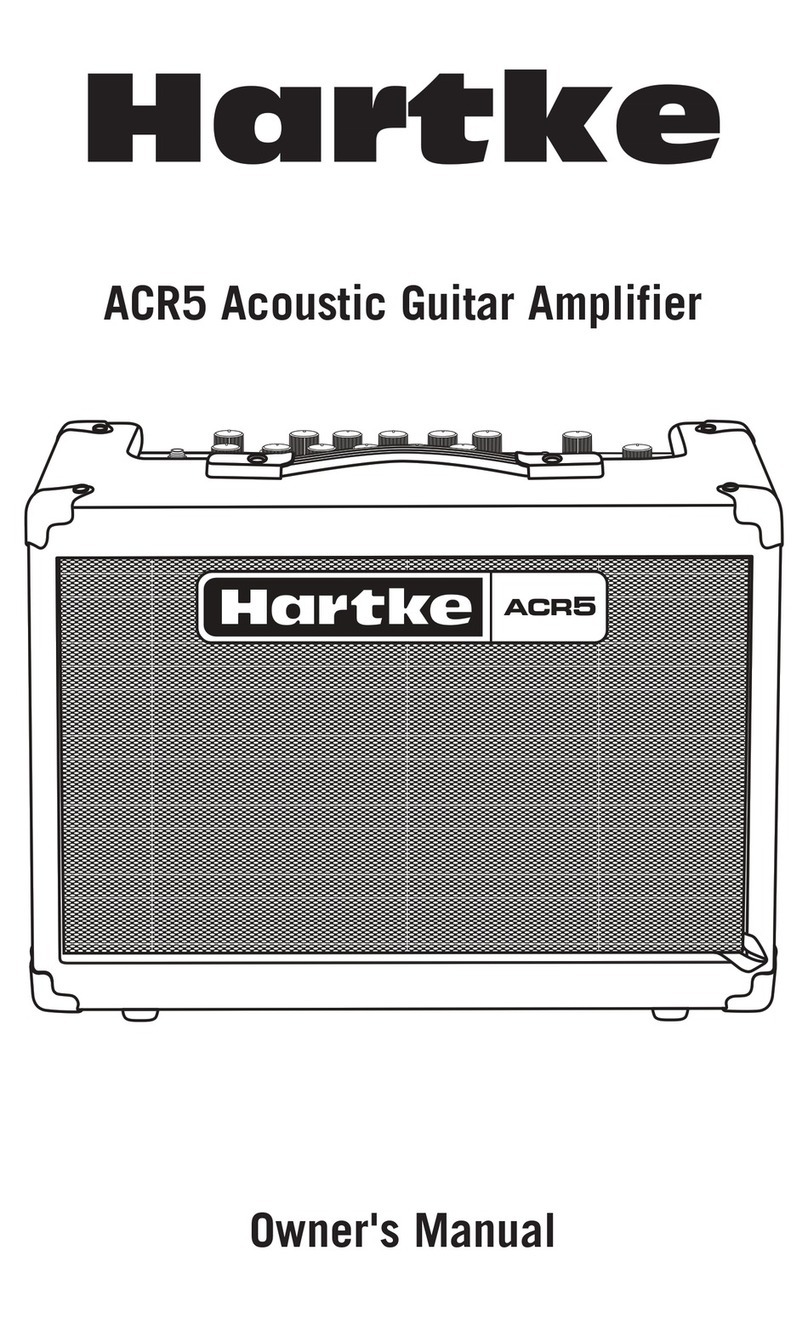
Hartke
Hartke ACR5 User manual
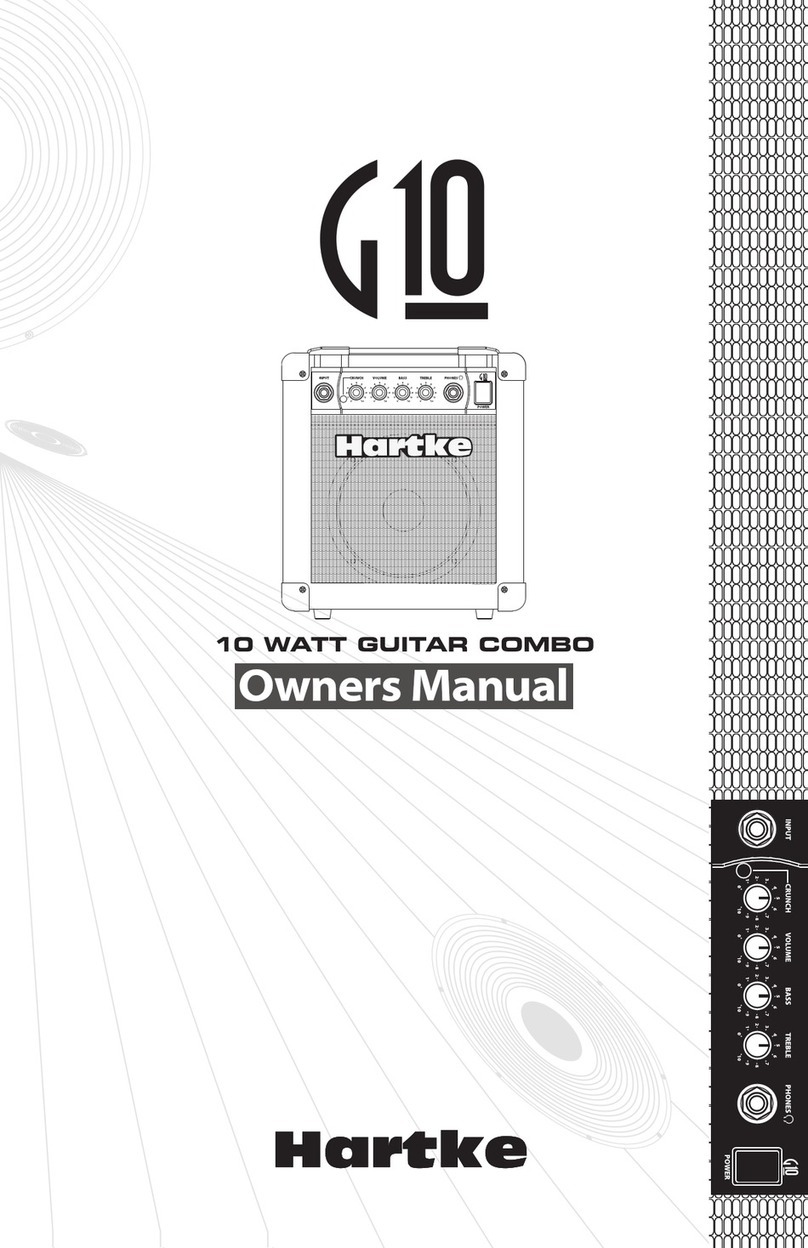
Hartke
Hartke G10 User manual
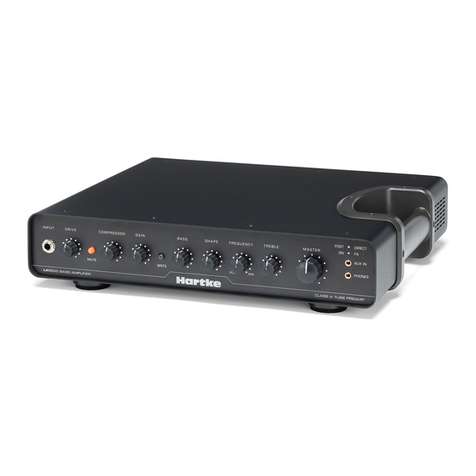
Hartke
Hartke LX8500 User manual
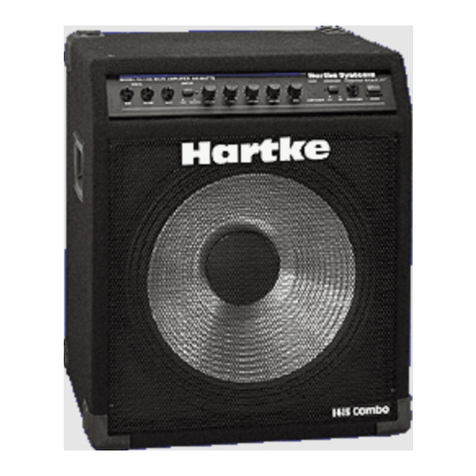
Hartke
Hartke Transient Attack 1400 User manual
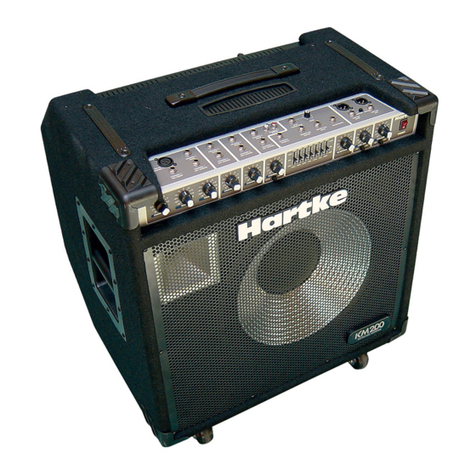
Hartke
Hartke KM200 User manual
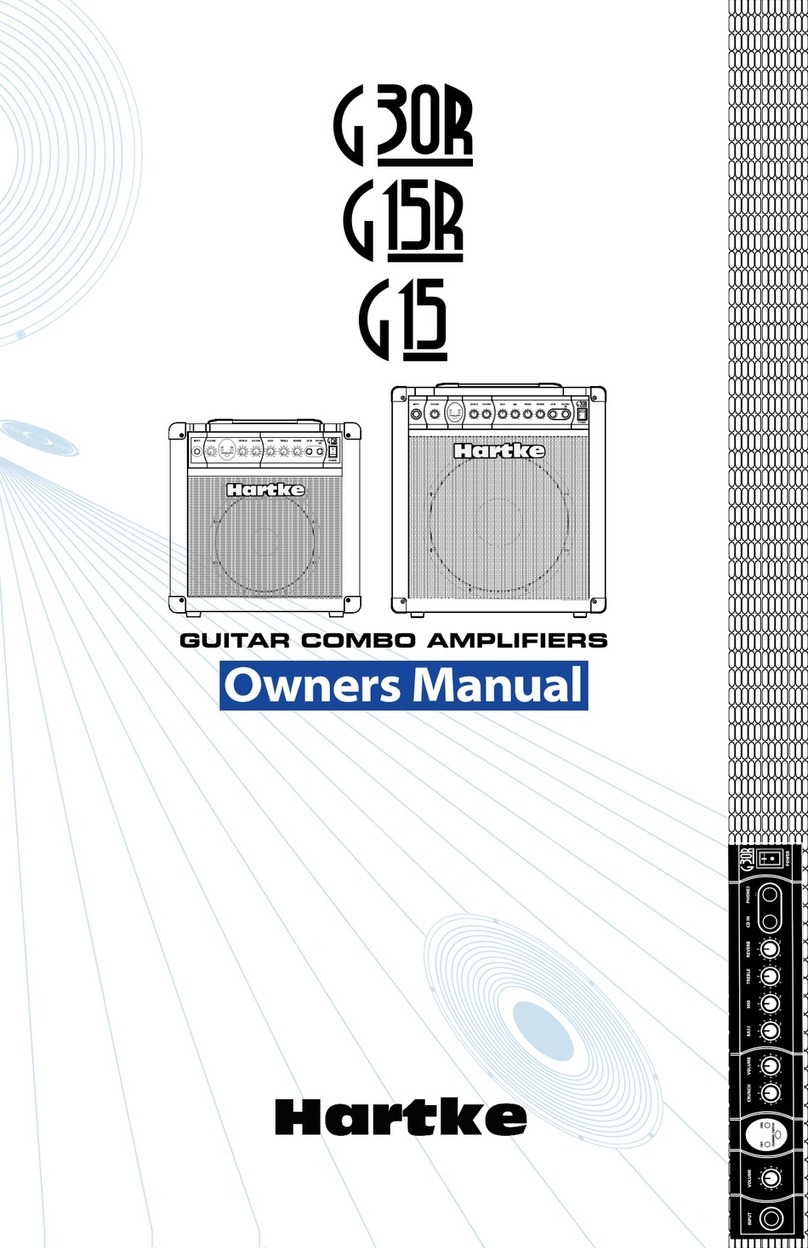
Hartke
Hartke G15 User manual
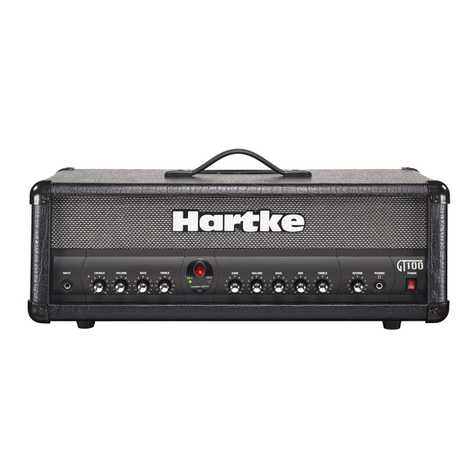
Hartke
Hartke GT100 User manual

Hartke
Hartke HD15 User manual
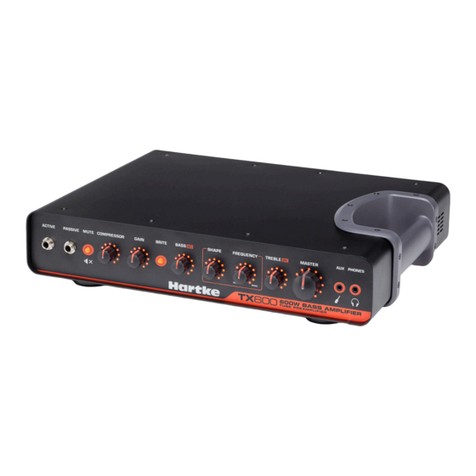
Hartke
Hartke TX600 User manual
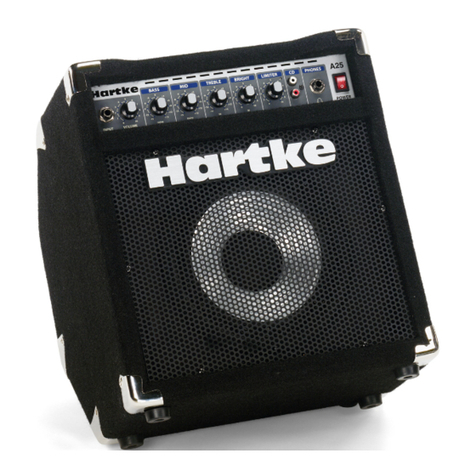
Hartke
Hartke A25 User manual
